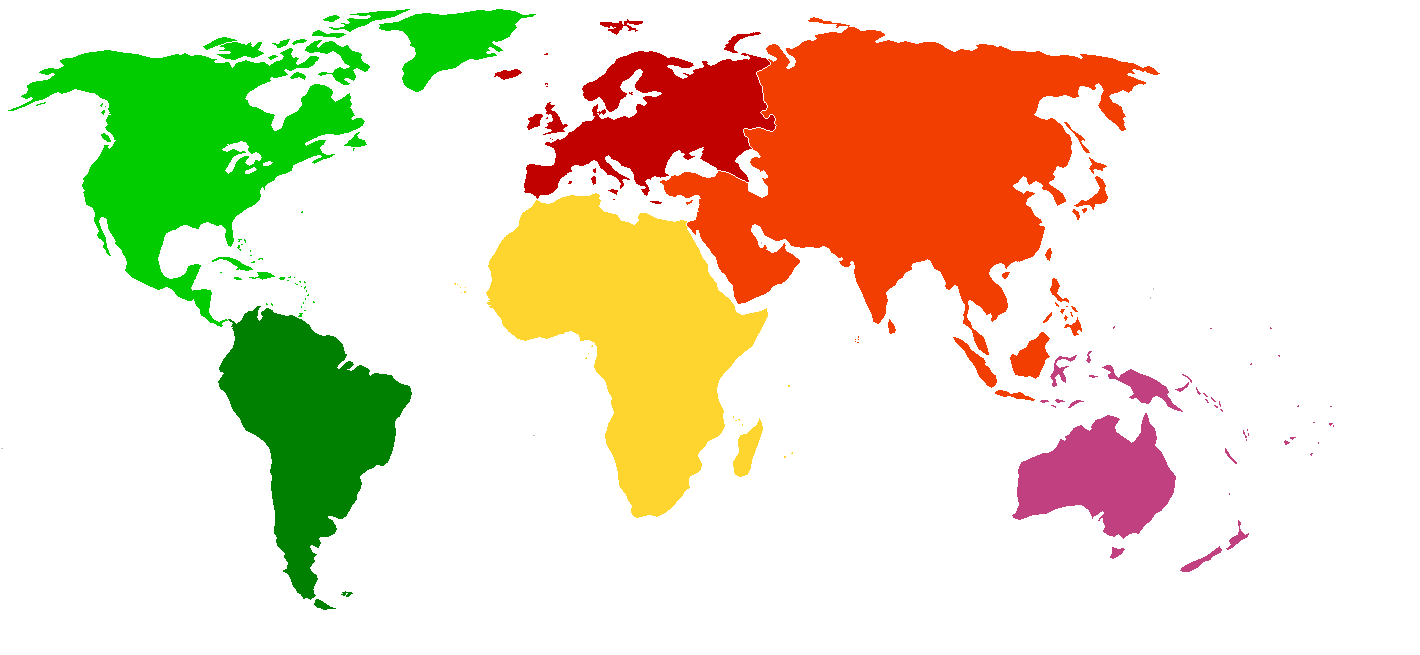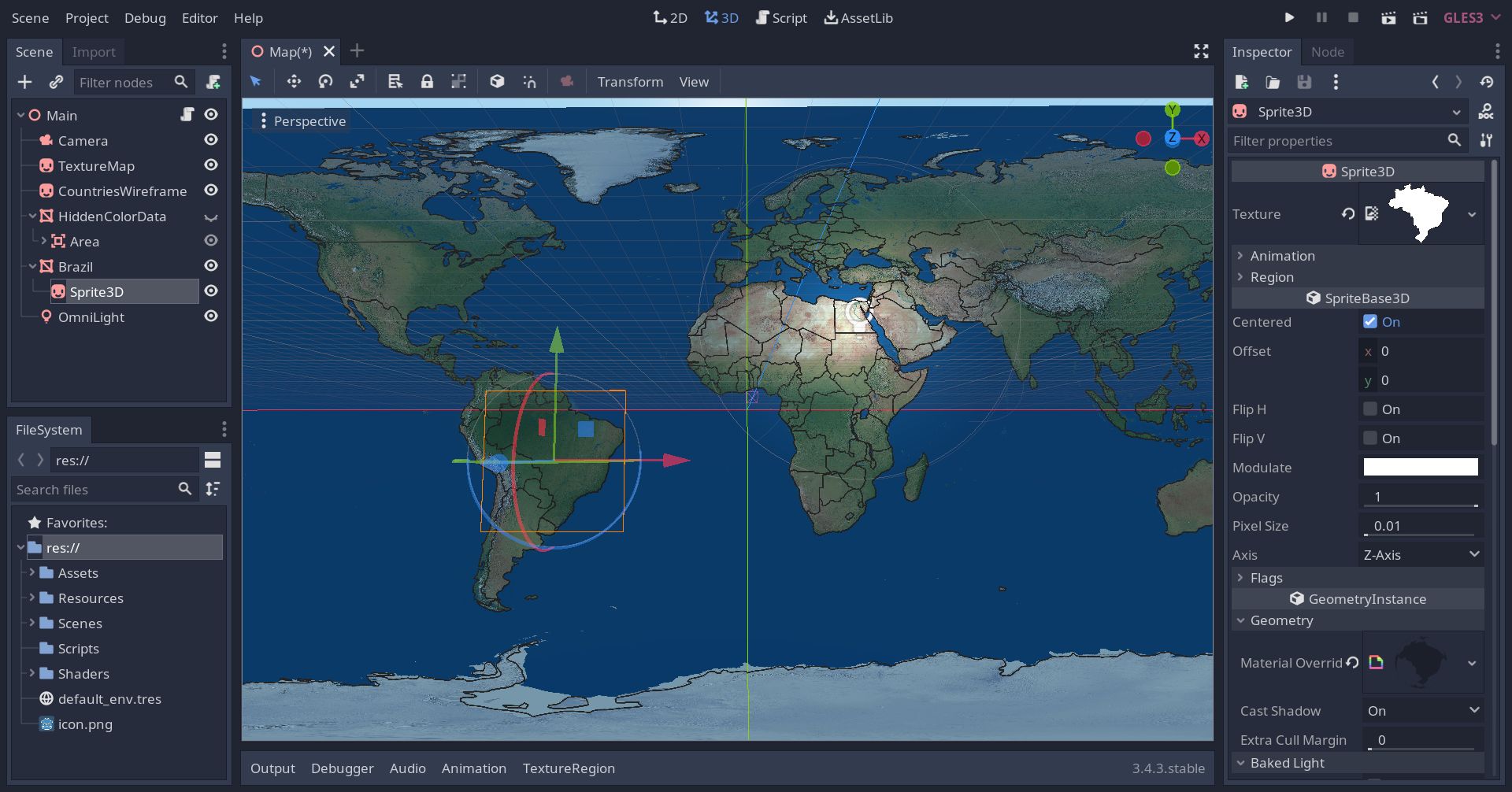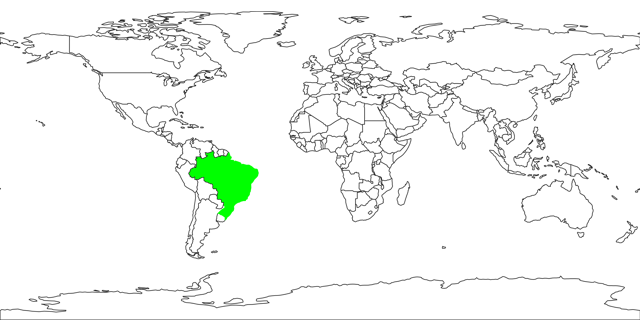Collision Detection Using a Color Map
After some searching, I saw an interesting way to create a clickable map that seems efficient and composed of two maps. The first is visible without any collision detection (our wireframe), and the second is in front with a unique color for each country, and it has a collider. Then, we check the pixel color from the mouse’s position; if it’s pink, we know it’s Australia. We can scale it down to countries, then regions, etc. Here’s the example from StackExchange:
 Map of all countries
Map of all countries
 Each region will have a unique color
Each region will have a unique color
Understanding the Workflow
 Godot workflow
Godot workflow
I created the following workflow: TextureMap and CountriesWireframe are simple 3DSprites. HiddenColorData is a QuadMesh I manually scaled to the size of the TextureMap, and it has a collider that will be used for get_pixel().
Code Snippets
I encountered an excellent post on Reddit which already implemented what I wanted. I mainly used the asset the author highlighted for camera calculations with ray casting: we perform a ray cast from the camera to the point on the invisible (color) map, then it gets the pixel and we decide what this pixel means (which country was selected).
1
2
3
4
5
6
7
8
9
10
onready var _hidden_quad_color_data = $HiddenColorData
func _ready():
# Load the color-coded map to the QuadMesh (HiddenQuadColorData) and lock it so we can pick its colors.
var temp_texture = ImageTexture.new()
var temp_image = Image.new()
temp_image.load("res://Assets/Maps/Images/World Map/world_map_colors.png")
temp_texture.create_from_image(temp_image)
_hidden_color_map_ = temp_texture.get_data()
_hidden_color_map_.lock()
Here are the maps, currently only Brazil has a color (green):
 A visible map which will be shown to the player
A visible map which will be shown to the player
 A hidden map with unique colors for each country. Only Brazil for now
A hidden map with unique colors for each country. Only Brazil for now
Camera movement:
1
2
3
4
5
6
7
8
9
10
func _physics_process(delta):
# Define -1 to +1 direction changes
cam_direction.x = (-int(Input.is_action_pressed("map_left")) + int(Input.is_action_pressed("map_right")))
cam_direction.y = (-int(Input.is_action_pressed("map_down")) + int(Input.is_action_pressed("map_up")))
cam_direction.z = (-int(Input.is_action_pressed("map_zoom_in")) + int(Input.is_action_pressed("map_zoom_out")))
cam_direction = cam_direction.normalized()
# Interpolate velocity and modify cam position
cam_velocity = cam_velocity.linear_interpolate(cam_direction * cam_speed, cam_acceleration * delta)
_camera.transform.origin += cam_velocity
Handling hover and click event:
1
2
3
4
5
6
7
8
9
10
11
12
13
14
15
16
17
18
19
20
21
22
23
24
25
26
27
28
29
30
31
32
33
34
35
36
37
38
39
40
41
42
43
44
45
46
47
48
49
50
func _unhandled_input(event):
# Handling both hover and click
# InputEventMouseButton & InputEventMouseMotion different logic!
if event is InputEventMouseButton or event is InputEventMouseMotion:
if _hidden_color_map_ == null: return false
# Get mesh size to detect edges and make conversions
# This code only support PlaneMesh and QuadMesh
var quad_mesh_size = _hidden_quad_color_data.mesh.size
# Find mouse position in Area
var from = _camera.project_ray_origin(event.global_position)
var dist = 100
var to = from + _camera.project_ray_normal(event.global_position) * dist
var result = get_world().direct_space_state.intersect_ray(from, to, [], _hidden_quad_color_data.get_child(0).collision_layer,false,true)
var mouse_pos3D = null
if result.size() > 0: mouse_pos3D = result.position
# Check if the mouse is outside of bounds, use last position to avoid errors
# NOTE: mouse_exited signal was unreliable in this situation
var is_mouse_inside = (mouse_pos3D != null)
if is_mouse_inside:
# Convert click_pos from world coordinate space to a coordinate space relative to the Area node.
# NOTE: affine_inverse accounts for the Area node's scale, rotation, and translation in the scene!
mouse_pos3D = _hidden_quad_color_data.get_child(0).global_transform.affine_inverse() * mouse_pos3D
_last_mouse_pos3D = mouse_pos3D
else:
mouse_pos3D = _last_mouse_pos3D
if mouse_pos3D == null:
mouse_pos3D = Vector3.ZERO
# convert the relative event position from 3D to 2D
var mouse_pos2D = Vector2(mouse_pos3D.x, -mouse_pos3D.y)
# Right now the event position's range is the following: (-quad_size/2) -> (quad_size/2)
# We need to convert it into the following range: 0 -> quad_size
mouse_pos2D.x += quad_mesh_size.x / 2.0
mouse_pos2D.y += quad_mesh_size.y / 2.0
# Then we need to convert it into the following range: 0 -> 1
mouse_pos2D.x = mouse_pos2D.x / (quad_mesh_size.x)
mouse_pos2D.y = mouse_pos2D.y / (quad_mesh_size.y)
# Finally, we convert the position to the following range: 0 -> _hidden_color_map_.size
mouse_pos2D.x = mouse_pos2D.x * _hidden_color_map_.get_width()
mouse_pos2D.y = mouse_pos2D.y * _hidden_color_map_.get_height()
# Detect country color code
var px_color = _hidden_color_map_.get_pixelv(mouse_pos2D)
# Decide what to do
if event is InputEventMouseButton:
mouse_button_country_handler(px_color)
elif event is InputEventMouseMotion:
mouse_motion_country_handler(px_color)
By the time of writing this post, I already created a shader to select countries (I’ll write about it next). The code below refers to that shader:
1
2
3
4
5
6
7
8
9
10
11
12
13
14
15
16
17
18
19
20
21
22
23
24
25
_current_selected_country = null # Should be at the top of your script
# If the country clicked, create a border.
func mouse_button_country_handler(country_color_code):
if country_color_code == Color(0,1,0) \ # Green color
and _current_selected_country != "Brazil":
_brazil.material_override.set_shader_param("IsOutlined", true)
# Store locally the current selected country
_current_selected_country = "Brazil"
elif country_color_code != Color(0,1,0): # Green color
# Reset selection effect
_current_selected_country = null
_brazil.material_override.set_shader_param("IsOutlined", false)
_brazil.material_override.set_shader_param("ColorAlbedoUniform", Color.black)
# If the country hovered, highlight it gently.
func mouse_motion_country_handler(country_color_code):
if country_color_code == Color(0,1,0) \ # Green color
and _current_selected_country != "Brazil":
_brazil.material_override.set_shader_param("ColorAlbedoUniform", Color.red)
elif _current_selected_country != "Brazil":
# Reset hover effect
_brazil.material_override.set_shader_param("ColorAlbedoUniform", Color.black)
Any code related to the camera is a combination of the asset mentioned above and the code made by the author of the reddit post - link to his repo.
If you get a side-effect of non-consistent layers’ locations when moving the camera, make sure you only translate the parent node - any child’s translations should set to 0.